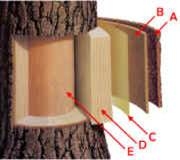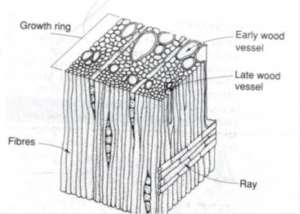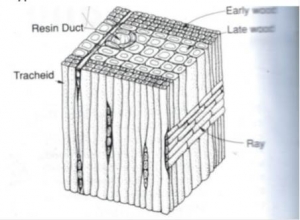Explore the Layers of a Tree
- The outer bark is the tree’s protection from the outside world. Continually renewed from within, it helps keep out moisture in the rain and prevents the tree from losing moisture when the air is dry. It insulates against cold and heat and wards off insect enemies.
- The inner bark, or “phloem,” is the pipeline through which food is passed to the rest of the tree. It lives for only a short time, then dies and turns to cork to become part of the protective outer bark.
- The cambium cell layer is the growing part of the trunk. It produces new bark annually and new wood in response to hormones that pass down through the phloem with food from the leaves. These hormones, called “auxins,” stimulate growth in cells. Auxins are produced by leaf buds at the ends of branches as soon as they start growing in spring.
- Sapwood is the tree’s pipeline for moving water up to the leaves. Sapwood is new wood. As newer rings of sapwood are laid down, inner cells lose their vitality and turn to heartwood.
- Heartwood is the central, supporting pillar of the tree. Although dead, it will not decay or lose strength while the outer layers are intact. A composite of hollow, needlelike cellulose fibers bound together by a chemical glue called lignin, it is in many ways as strong as steel. Set vertically, a piece 12″ long and 1″ by 2″ in cross section can support a weight of 20 tons!
Source: Arbor Day Foundation: http://www.arborday.org/trees/ringsTreeNatomy.cfm
Hardwood vs. Softwood
Hardwood lumber is produced mostly from deciduous trees—those which drop their leaves each year—in contrast to the coniferous or evergreen species from which our softwoods are produced.
The difference between the two is less about the hardness and density of the wood and more about the cellular structure, so wood that you might assume is a softwood isn’t necessarily so. Balsa is an example of a soft hardwood while Yew is an example of a hard softwood.


